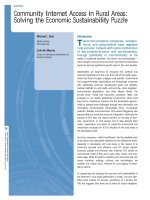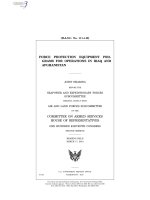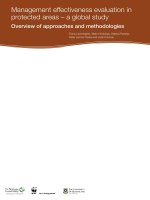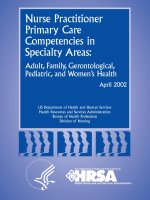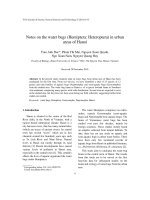MULTIPLE UNMANNED VEHICLES OPERATIONS IN CONFINED AREAS
Bạn đang xem bản rút gọn của tài liệu. Xem và tải ngay bản đầy đủ của tài liệu tại đây (1.74 MB, 164 trang )
MULTIPLE UNMANNED VEHICLES OPERATIONS
IN CONFINED AREAS
ZHANG QIAN
(B.Eng, Harbin Institute of Technology)
A THESIS SUBMITTED
FOR THE DEGREE OF DOCTOR OF PHILOSOPHY
DEPARTMENT OF MECHANICAL ENGINEERING
NATIONAL UNIVERSITY OF SINGAPORE
2015
i
Acknowledgements
First of all, I would like to express my sincerest gratitude to my supervisor,
Assoc. Prof. Gerard Leng Siew Bing, for his continuous guidance and
encouragement during my studies. He always gives me invaluable advice and
shows me the direction, every time I feel confused. I am grateful for his
support and patience over the years.
I would also like to present my gratitude to my fellow colleague,
Vengatesan Govindaraju, for his discussion on research, encouragement and
concern over the past years. I also wish to thank all my dear friends and all the
staff in Dynamics Lab for their help and pleasant memories. I am also thankful
to my friends, who always accompany me and give me confidence all the time.
I want to gratefully acknowledge China Scholarship Council (CSC) and
the embassy of China for the financial support during my PhD study. I am
truly thankful to National University of Singapore for the environment and
resources provided.
Last but not least, I would like to deeply thank my parents for their
consistent understanding and encouragement. They give me unconditional
love and all-around support.
ii
Table of Contents
Acknowledgements i
Table of Contents ii
Summary vii
List of Tables ix
List of Figures x
List of Symbols xiii
Chapter 1. Introduction 1
1.1 Background 2
1.1.1 Introduction to Multi-vehicle Systems 2
1.1.2 Task Planning in Confined Area 3
1.1.3 Simulation Tools 4
1.2 Scope and Objectives 6
1.3 Contributions 8
1.4 Thesis Organization 9
Chapter 2. Literature Review 10
2.1 Study Fields of Multi-Robot System 10
2.1.1 Pattern Formation and Control Systems 10
iii
2.1.2 Mapping and Localization 12
2.1.3 Collision Detection and Assessment 13
2.1.4 Path Planning and Collision Avoidance Methods of UxVs 15
2.2 Swarm Robotics 17
2.2.1 Design of Swarm System 18
2.2.2 Behaviour Analysis 19
2.3 Nonholonomic Vehicles 20
2.4 Conclusion 21
Chapter 3. Time to First Collision for Vehicles with Zero Turn Radius in a
Confined Area 22
3.1 Time to First Collision for Vehicles without Collision Avoidance in an
Open Area 23
3.1.1 Introduction to Mean Free Path 24
3.1.1.1 Basic Principles in Physics 24
3.1.1.2 Calculation of Mean Free Path 26
3.1.2 Time to First Collision Using the Mean Free Path 28
3.2 Model of Vehicle 30
3.3 Derivation of formula for the Mean Time to First Collision 34
3.3.1 Probability of Collision for Two Vehicles 34
3.3.2 Mathematical Formulation 39
iv
3.4 Analysis of Results 45
3.5 Simulation and Discussion 46
3.5.1 Simulation Environment 47
3.5.2 Parameters of Vehicles and Workspace 47
3.5.3 Flow Chart of Program 49
3.5.4 Simulation Results 50
3.5.4.1 Speed and Field of View Fixed 51
3.5.4.2 Speed and the Number of Vehicles Fixed 52
3.5.4.3 FOV and the Number of Vehicles Fixed 53
3.5.5 Discussion 54
3.6 Conclusion 58
Chapter 4. Time to First Collision for Dubins’ Vehicles with Non-zero
Turn Radius in a Confined Area 60
4.1 Introduction to Velocity Obstacle 60
4.2 Model of Dubins‟ Vehicle 63
4.3 Motion Pattern of Vehicles 65
4.3.1 Rectilinear Motion 66
4.3.1.1 Rectilinear Motion without Considering Collision
Avoidance 66
4.3.1.2 Average Distance of Rectilinear Motion 68
v
4.3.2 Turning motion 71
4.4 Derivation of Formula for Mean Time to the First Collision 71
4.4.1 General Formulation 71
4.4.2 Variables and Parameters 73
4.5 Analysis of Results 76
4.5.1 Approximation of Integration 76
4.5.2 Critical Number of Vehicles 81
4.6 Simulation and Discussion 82
4.6.1 Parameters of Vehicles and Workspace 83
4.6.2 Flow Chart of Program 85
4.6.3 Simulation Results 86
4.6.3.1 Effect of the Number of Vehicles 87
4.6.3.2 Effect of Acceleration and Speed 92
4.7 Conclusion 95
Chapter 5. Conclusions and Future Works 97
5.1 Conclusions 97
5.2 Limitations and Future works 100
Bibliography 102
Publications 118
vi
Appendix I. MATLAB Code: the Time to First Collision for Vehicles with
Zero Turn Radius 119
Appendix II. MATLAB Code: the Time to First Collision for Dubins’
Vehicles 129
Appendix III. Simulation Environment 143
A. Monte Carlo simulation 143
B. Curve Fitting Toolbox 145
vii
Summary
The thesis aims to derive the time to first collision of multiple unmanned
air/land/surface vehicles (UxVs) operating in a confined area. Here a collision
is defined as two UxVs coming within a critical distance of each other. The
effect of different vehicle and collision avoidance models are studied using the
concept of a mean-free path inspired by molecular dynamics.
The time to first collision is derived for two cases of UxVs operating in
a confined area. For the first case, the vehicles move with constant speeds with
zero turn radius but have blind spots in detecting obstacles. The collision
avoidance method is to turn 90° away from another oncoming vehicle. An
expression for the time to first collision is derived as a function of the number
of UxVs, the UxV speed and the sensor field of view (FOV) for a given
operational area and vehicle size. The predicted time to first collision was
verified by Monte-Carlo simulation. Furthermore, the theory indicates the
existence of a critical time, above which collision is deemed to occur instantly.
This critical time provides an estimate of the maximum number of UxVs that
can safely operate in a given area.
In the second case, Dubins‟ vehicles were considered i.e.
nonholonomic vehicles with constant speed and finite turn radius. The velocity
obstacle method is used for collision avoidance. The time to first collision is
derived in a similar manner and is now a function of the number of vehicles,
speed as well as the vehicle‟s lateral acceleration. The theory agreed with the
viii
Monte Carlo simulations and the critical number of UxVs that can operate
safely increases with decreasing finite turn radius. The results provide useful
guidelines for the safe operations of UxV in confined areas and the method
may be applied to other vehicle models and collision avoidance methods.
ix
List of Tables
Table 3.1 Critical number of vehicles when
= 5s 56
Table 4.1 Constants obtained from simulations 90
x
List of Figures
Figure 1.1 Cooperative multi-UxV system [4] 3
Figure 1.2 User interface of MATLAB [5] 5
Figure 3.1 Critical condition of collision for two molecules. The solid circles
show the vehicles with diameter , and the dashed circle shows the virtual
circle with radius . 25
Figure 3.2 The dashed inner cylinder is swept out by the solid circle in Figure
3.1, while the solid outer cylinder is swept out by the virtual circle in Figure
3.1. The red dots represent the centres of molecules that are within the outer
cylinder 26
Figure 3.3 The inner rectangle is swept out by the reference vehicle, and the
outer rectangle is swept out by virtual circle. 29
Figure 3.4 Model of vehicle is a disk centred at point O with a sensor mounted
at point G. The shaded area is sensing area. 32
Figure 3.5 Vehicle rotates 90° to avoid the obstacle. 32
Figure 3.6 The critical case where the reference vehicle O just cannot detect
the obstacle vehicle O‟. 34
Figure 3.7 Example of the contacting point A when collision happens. 35
Figure 3.8 Relative velocity components along the line of two centres. 36
Figure 3.9 Two critical conditions of relative positions and postures when
collision happens. (a) two vehicles just cannot detect each other (b) the
velocities of two vehicles are parallel. 37
Figure 3.10 Included angles of velocities in two critical cases (a) included
angle: 180 (+ 2) (b) included angle: 0 38
Figure 3.11 Distance between two centres of vehicles when collision happens.
41
Figure 3.12 The area that is swept out by the reference vehicle when it moves
in a confined area 41
Figure 3.13 Critical condition of collision for vehicles. 42
Figure 3.14 Collisions can be avoided if they are within the area +
. 43
xi
Figure 3.15 Diagram of workspace in coordinate system. 48
Figure 3.16 Visualized interface of the running program. 49
Figure 3.17 Flow graph of the program for calculating the time to first
collision for vehicles with zero turn radius in a confined area. 50
Figure 3.18 (a) Fit curve and residuals with respect to when = 1m/s, =
60°. (b) residuals of the fitting curve 52
Figure 3.19 (a) Fit curve and residuals with respect to when = 1m/s, =
14. (b) residuals of the fitting curve. 53
Figure 3.20 (a) Fit curve and residuals with respect to when = 20, =
90°. (b) residuals of the fitting curve 54
Figure 3.21 Critical number of vehicles when
= 5s with respect to
different speeds and FOVs. 58
Figure 4.1 The diagram of velocity obstacle 63
Figure 4.2 Velocity Obstacle of
63
Figure 4.3 Dubins‟ vehicle in a coordinate system 64
Figure 4.4 Two kinds of motions for the vehicles in this study: rectilinear
motion and turning motion. 66
Figure 4.5 The rectangle swept out by a vehicle in 2D. 68
Figure 4.6 Velocity obstacle between vehicles A and B. 71
Figure 4.7 Diagram of turning motion. The shaded area is swept out by the
reference vehicle. 73
Figure 4.8 Relationship between the relative velocity and two random
velocities. 74
Figure 4.9 Comparism of 2nd-order Taylor expansion of the integration and
the original integration. 80
Figure 4.10 Comparism of 4th-order Taylor expansion of the integration and
the original integration. 81
Figure 4.11 Visualized interface of the running program for Dubins‟ vehicles.
84
Figure 4.12 Flow graph of the program for calculating the time to first
collision for Dubins‟ vehicles with non-zero turn radius in a confined area. 86
xii
Figure 4.13 (a) Fit curve and residuals with respect to when = 1m/s, =
2.6m/s
2
. (b) residuals of the fitting curve. 89
Figure 4.14 Effect of varying acceleration from 1m/s2 to 3.8m/
2
. 91
Figure 4.15 Data of Figure 4.14 presented in one plot. 92
Figure 4.16 Fit Comparison between theoretical curve and mean value points
from simulation when v=1m/s, n=22. 94
Figure 4.17 Comparison between theoretical curve and mean value points
from simulation when v=1m/s, n=24. 94
Figure 4.18 Comparison between theoretical curve and mean value points
from simulation when a=2.4 m/s
2
, n=24. 95
Figure A.1 Diagrammatic sketch of Monte Carlo simulation. The red dots are
simulation points and the black curve is theoretical curve. 144
Figure B.1 The interface of Curve Fitting Tool in MATLAB. 146
xiii
List of Symbols
diameter of gas molecules/radius of virtual circles of gas
molecules
time interval
density of gas molecules or UxVs
,
average relative speed between molecules or UxVs
absolute speed of molecules or UxVs
length of mean free path
a constant
radius of UxVs
rectangle area swept out by UxV
,
1
the number of vehicles that the reference vehicle will
encounter in unit time
average time between two successive collisions of a UxV
radius of UxVs
sensor range of UxVs
an angle subtended by sensing region
radius of sensor range
the angle subtended by the connecting line between two
centres of vehicles and sensing boundary
the angle subtended by the connecting line between two
centres of vehicles and x axis
relative velocity component along the line of two centres
of UxVs
xiv
probability of collision once two UxVs encounter
area of operation area
total number of UxVs in the confined area
(,
)
effective vehicle radius
1
the constant to convert average absolute velocity to
average relative velocity
2
modification term
constant in the modification term
0
the number of collisions in unit time
the time to first collision in the confined area
constant in the formula
,
,
1
,
2
substitution terms
critical number of UxVs
cr
critical time to first time
, y
position coordinates
time step in simulation
2
coefficient of determination
a, ,
the equivalent constants when some variables are fixed
,
positions of the centres of vehicles a and b
position of a vehicle
,
velocities of vehicles a and b
relative velocity between a and b
(
),
(
)
radii of vehicles a and b
xv
equivalent radius of a and b
(, )
the ray that start from along the direction of
velocity obstacle of b relative to a
angular speed
the maximum acceleration of a UxV
radius of UxV
equivalent safety distance
length of rectilinear motion
length of turning motion
radius of curvature
the number of obstacle vehicles within the rectangular area
the probability that the direction of relative velocity is
within the cone
distance between a and b
half angle of the cone
mean probability
average value of function ()
certain angle turned by UxV
length of a cycle
the number of cycles in unit time
the area swept out by UxV while turning
the number of collisions in a cycle
the number of collisions in unit time
xvi
average relative velocity
(,
)
a term to make up the effect of boundaries
the integral term in the formula
polynomial of the th order Taylor expansion
remainder of the th order Taylor expansion
the length of path during
the number of collisions during
1
Chapter 1. Introduction
Autonomous unmanned air/land/surface vehicles (UxVs) are playing
important roles in many applications, due to their advantages over piloted
vehicles. Particularly, multiple unmanned vehicle system, in which the
vehicles can conduct a common task by cooperation without requirement of
human control and supervision, has attracted much attention from researchers.
UxVs can be used in dangerous or inconvenient environments where it is hard
for humans to access or operate. Usually, sensors are mounted in vehicles, so
that information about the behavior of the vehicle and the situation around it
can be transferred to the operator, who is far from the workspace. This also
provides the possibility for UxVs to be applied in military missions. In
addition, a task may be completed by multiple low-cost cooperative UxVs
more quickly and efficiently than a single UxV.
Task planning is a prerequisite for the deployment of multiple UxVs. In
order to ensure the safety of the UxVs, a careful choice of parameters such as
the vehicle density and allowable speed is necessary. Therefore, the objective
of this thesis is to explore the time to first collision for multiple UxVs
operating in a confined area. Different vehicle models and collision avoidance
techniques will be discussed in the following chapters.
2
1.1 Background
1.1.1 Introduction to Multi-vehicle Systems
With the rapid development of sensors, control system, computer science and
robotics, multi-vehicle cooperative system has become a research topic of
much interest [1-3]. A multi-vehicle system is defined as a system of multiple
dynamic entities that share information or tasks to accomplish a common,
though perhaps not singular, objective. Multiple vehicles are more effective
than a single vehicle robot in many tasks, for example localization and
mapping. They can complete cooperative works which cannot be done by
single vehicle, for example robo-soccer as shown in Figure 1.1. It has been
observed that multi-vehicle systems can also accomplish tasks with less cost
compared to a single vehicle with full capabilities. Therefore, a lot of research
effort has focused on studying multi-vehicle system, and some challenges
remain. The most basic problem in deploying multiple vehicles is to avoid
collision among the vehicles. Some related researches involve communication,
coordination, path planning and obstacle avoidance.
The vehicles in multi-vehicle system need to interact and cooperate with
each other to conduct tasks, so the communication between them is quite
important. There are many different ways of communication and decision
making. In addition, path planning with collision avoidance is one of the most
important issues for UxVs. The path can be scheduled according to the
mechanics and dynamic constraints of the UxVs, as well as the environment in
which the UxVs are maneuvered. There are many path planning and collision
3
avoidance methods, for example the potential field method. UxVs can be
categorized into holonomic vehicles and nonholonomic vehicles. Our studies
are conducted using nonholonomic vehicles, and two kinds of nonholonomic
vehicles are applied.
Figure 1.1 Cooperative multi-UxV system [4]
1.1.2 Task Planning in Confined Area
Many issues, for example communication and localization, must be considered
for a cooperative system of UxVs. Among all the issues on cooperative UxVs,
the assurance of safety is the most basic one, and the maneuver of vehicles
must be decided beforehand to avoid collision. While operating in the
workspace, the UxVs have to avoid collision not only with each other, but also
with the obstacles around them. For vehicles moving in a confined area, the
4
boundaries of the workspace also need to be avoided. Therefore, task planning
before operating is extremely important, for example how many vehicles
should work together at one time, and what the speed of them should be. The
method of collision avoidance should also be considered to ensure the safety
of vehicles. Collision checking is the first step to avoiding collision. This
requires the definition of collision and the principle of checking collision.
Consequently, the way to calculate the time to first collision for multiple
vehicles will be studied in this research, so that we can know how the
parameters of the mulit-UxV system affect collision probability. This study
will make it possible to do task planning for some specific systems.
1.1.3 Simulation Tools
In this research, the mathematical simulation software MATLAB (matrix
laboratory) is used to verify the theories that are developed and to find the
parameters in the formula in some specific cases. MATLAB is a high level
programming language, but can interface with the programs that are written in
other languages, such as C, C++, Java. The algorithms can be developed faster
than that developed by traditional languages, because low-level administrative
tasks are not needed. The functions in MATLAB can also be integrated with
other applications and languages. MATLAB was designed for numerical
computing primarily, but now it is a powerful tool in solving mathematical
problems and application development. Large amount of functions are
provided to deal with problems like differential equations, Fourier analysis,
filtering, integration and so on. The user interface is shown in Figure 1.2.
Many tools in MATLAB make it possible to develop algorithms
5
efficiently, including Command Window, MATLAB Editor, Code Analyzer
and MATLAB Profiler. Processor-optimized libraries are used to execute
matrix and vector computations faster. Besides, just-in-time (JIT) compilation
technology is used to accelerate the speed than low-level programming
languages.
An advantage of MATLAB is the graphical user interface, including
GUIDE (GUI development environment). Simulation graphics can be seen and
analyzed explicitly. In addition, many toolboxes are provided in MATLAB.
The functions in toolboxes can perform some specific calculations
conveniently. The Curve Fitting toolbox will be used in our research to
validate the theory developed.
Figure 1.2 User interface of MATLAB [5]
6
1.2 Scope and Objectives
Multi-UxV system is still a challenging topic due to the communication
between vehicles, path planning, etc, while the research in this thesis focuses
on task planning of the vehicles. Safety is a significant premise of completing
a task for multiple vehicles, so we always try to keep the probability of
collision low. Therefore, before the beginning of any multi-UxV task, the
planning on multi-UxV system is necessary to make sure a smooth operation.
The planning includes the number of vehicles, range of sensors and so on.
Different models of vehicles have different characteristics and motion pattern,
so the planning should be made based on the scenario.
As introduced in section 1.1, many studies have been conducted on multi-
UxV systems, including communication, control of motion, path planning, etc.
All of the studies contribute to the development of effective and efficient
multi-UxV system. Most of these studies focused on a specific problem to be
solved, which cannot work well to other cases, and the studies rarely analyze
the probability or conditions for collision to occur. Therefore, we would like to
find a method derive the time to first collision in a confined area. In this
research, we consider the case where the vehicles move freely with the same
motion pattern. The time to first collision is studied in terms of different
vehicle models and collision avoidance techniques. We study the effect of
factors such as the number of vehicles within a confined area, vehicle speed
and sensor range on the probability of collision and hence the time to first
collision.
7
The objective of this research is to find the time to first collision within a
confined area with respect to some different vehicle models and motion
patterns. First, it is found that the motion for vehicles without collision
avoidance in an open area is similar to that of gas molecules, so the derivation
of Mean Free Path from molecular dynamics is used to derive the time to first
collision. Different vehicles characteristics result in significant differences in
the results, so the subsequent study focuses on the time to first collision in
terms of two kinds of vehicle models and collision avoidance techniques. In
the first part, a specific model of vehicle with constant speed and zero turn
radius was proposed. The sensors on the vehicles have limited sensing range.
Because of the existence of blind spots, collisions may happen. The influence
of the factors to the time to first collision is identified and the effect of each
factor is quantified. The second part is on the operation of Dubins‟ vehicles
with finite turn radius. The collision avoidance technique used is based on the
concept of Velocity Obstacle. The formula of the time to first collision is also
derived. For both parts, the results were verified by Monte Carlo simulation.
A shorter time to first collision implies a higher probability of collision.
Specifically, if we define a critical time, below which collisions are deemed to
happen instantaneously, the relation among the parameters can be deduced.
This relationship can then be used as a reference in planning UxVs operations
within a confined area. The details of derivation will be described in the
following chapters.




